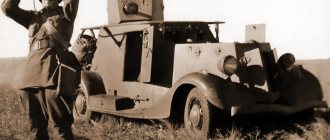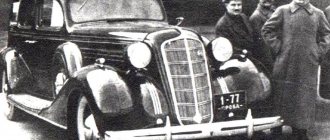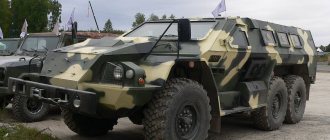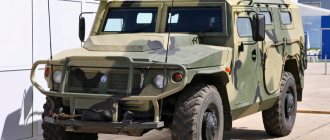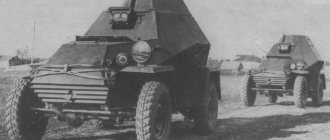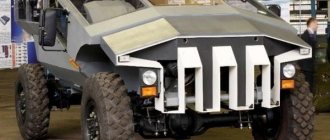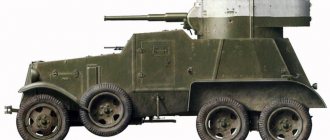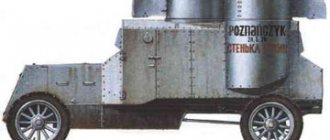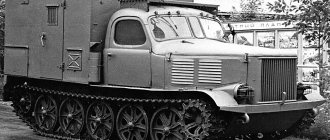Armored car Panhard 178 (AMD-35)
Light reconnaissance armored vehicle Panhard 178 (AMD-35)
By the beginning of the 1930s. The French military command put forward a new program for the development of armored cavalry units and units. By analogy with the division of tanks into light, medium and heavy, it provided for the creation of three types of armored vehicles: patrol, reconnaissance and combat, and the latter were supposed to be half-tracked. As part of this program, in 1931 a competition was announced for the development of a new wheeled reconnaissance armored vehicle (AMD - Auto-Mitrailleuse de Decouverte). The tactical and technical requirements for the vehicle were presented for discussion on December 22, 1931, then clarified on November 18, and finally approved on December 9 of the same year. According to them, the armored car was supposed to have a mass of about 4 tons, a cruising range of at least 400 km, a maximum speed of 70 km/h, a cruising speed of 40 km/h, a turning radius of 12 m, armament of a 20 mm gun and 7 .5 mm machine gun. Well-known automobile companies Pegeout, Berliet, Latil and Panhard took part in the competition. The most successful was the project of the Panhard company, which by October 1933 presented model 178, developed on the basis of the already operating machine 175. In the same month, a contract was signed with it for the construction of prototypes.
A specially created selection committee conducted long-term tests from January 9 to February 2, 1934, during which the armored car covered 1001 km on roads with an average speed of 43.5 km/h and a maximum speed of 68.5 km/h. In the conclusion of the commission, it was stated that the vehicle has good suspension, remains stable at high speeds, overcomes slopes up to 25° steep, as well as fords 0.6 m deep. One of the prototypes of the Panhard 178 even had two small tracks 0.9 m long under the bottom of the hull, making it easier to overcome steep slopes. In the fall of 1934, after military tests at the shooting range in Versailles and participation in cavalry maneuvers in Reims, the armored car was adopted by the French army under the designation AMD-35. It should be noted that the first order for 15 cars to the Panhard company was issued even earlier - on April 25. The contract amount (without turrets and weapons) was 275,000 francs. On May 20, the order was increased to 30 armored vehicles, which were produced by the end of 1934. The production vehicles were slightly different from the prototype. Their body became narrower and longer, the shape of the drivers' hatches changed, the muffler was moved outside, the engine compartment grille was changed, and tool boxes were installed. Most importantly, a large ARX-3 turret with a 25-mm Hotchkiss anti-tank gun of the 1934 model and a 7.5-mm Reibel machine gun appeared, developed by the Puteaux company. The gun's rate of fire reached 15 rounds/min. For firing, 320-gram armor-piercing tracer shells were used with an initial speed of 880 m/s. At a distance of 500 m, they pierced a vertically placed armor plate 40 mm thick. In the vertical plane, the gun was aimed at the target in the sector from -12° to +14°. The Reibel machine gun was mounted next to the cannon.
The ARKH-3 turret itself had a multifaceted shape and was riveted from 13-mm sheets of rolled steel. On its sloping front wall there was a round hatch with a lid that folded forward; the back wall provided a double door for the crew to exit. The thickness of the frontal armor of the turret reached 18 mm. In 1937, some improvements were made to the design of the AMD-35 armored car, which increased its reliability. Visually, these vehicles differed only in observation devices - they were equipped with tank periscopes designed by Gundlach - and minor changes in the turret and hatch design.
The Panhard 178 (AMD-35) armored car differed from other armored cars in its rear-engine layout. The driver was located in front, in the control compartment, which had the appearance of a forward-facing wheelhouse, and conducted observation through the front window, equipped with an armored hatch with a narrow viewing slot. The field of view was increased by windows in the side walls with armored covers. The completely enclosed riveted body of the machine was made from sheets of rolled steel with a thickness of 9 to 13 mm. The walls of the hull were installed vertically, but the upper frontal sheet had a large angle of inclination. The rear part of the vehicle was divided into four parts. In the center there was a radiator with a fan, at the back, one after the other, there were two gas tanks with a capacity of 118 liters and 23 liters. In front of the radiator on the right was a Panhard ISK 4FII bis engine with a power of 105 hp, and on the left was the driver’s aft control station. The muffler, mounted vertically outside the armored hull, protruded from the right side. Two side doors in the central part of the hull served for the entry and exit of the crew. The armored car was moving along the highway at a maximum speed of 72.6 km/h. The fuel range was 350 km. The vehicle is all-wheel drive, with four drive wheels on pneumatic tires, and is equipped with a reverse mechanism, which allowed it to move forward and backward at the same speed. Smooth ride was ensured by semi-elliptical leaf springs and hydraulic shock absorbers.
From the summer of 1934 to June 1940, 527 Panhard 178 reconnaissance armored vehicles were produced. By the time the French army mobilized in September 1939, 11 squadrons were armed with 218 AMD-35s. With the outbreak of the war, actual production began to lag significantly behind plans. The exception was May 1940, when 98 AMD-35s were produced against a plan of 40. The delay was mainly due to the lack of ARX-3 turrets. So, by May 17, 1940, 68 towers were missing. The last factory report dates back to June 7 of the same year. By this date, there were three ready-made armored vehicles, 55 were in production, but there were no turrets for them. Eleven days later, it was decided to install roofless roundhouses with six loopholes for firing from a light machine gun on 21 armored cars. Some of the vehicles were armed with 25-mm and 47-mm cannons behind the shields. In the spring of 1940, they took part in hostilities as part of armored cavalry units. The French resistance was short-lived. Most of the Panhards fell into the hands of the Germans in perfect condition and were used in Wehrmacht units under the designation PzSpah 204 (f). 200 armored cars entered the field troops and SS units: the largest number of them with standard French weapons ended up in the 7th and 20th Panzer Divisions. 43 vehicles were converted into armored tires, on which German radio stations with frame-type antennas were installed.
By June 22, 1941, there were 190 Panhard 178 armored cars on the Eastern Front: 107 of them were lost by the end of the year. As of June 1943, the Wehrmacht still had 30 armored cars on the Eastern Front and 33 on the Western Front. In addition, some of the cars had been transferred to police units by this time. The French government of Vichy received permission from the Germans to keep several Panhards at their disposal, but on the condition that the 25-mm guns were dismantled. True, on parts of armored cars they were replaced with a second machine gun. The French tried to start secret production of turrets with 25 mm and 47 mm guns. However, in November 1942, during the German invasion of the “free” zone in the south of France, they were all destroyed. The German authorities used the armored vehicles of the Vichy Army to “maintain order,” and in 1943 some of the vehicles that did not have turrets were armed with a 50-mm KwK L/42 tank gun mounted behind the shield. By the end of 1944, a number of “Panhards” were in de Gaulle’s 1st French Army and actively participated in the fighting. At the beginning of the war, units of the Red Army captured several of these armored cars as trophies. In 1942, they were repaired at a factory in Moscow. In 1945, production of the Panhard 178 in France resumed. Now they were equipped with a new FL-1 turret with a 47 mm SA35 cannon and a machine gun; such a turret was tested back in June 1940. The new armored vehicle was designated Panhard 178B. These machines were used first in France and then in the colonies. To this day, one “Panhard” has been preserved in the museum in Samyur (a copy was collected from several vehicles that were in New Caledonia), the other - a captured Pz.Spah.204 (f) - in Kubinka near Moscow; Perhaps such a machine is in the museum in Damascus (Syria).
TECHNICAL SPECIFICATIONS PANHARD 178 (AMD-35)
COMBAT WEIGHT, kg: 8500 CREW, persons: 4 DIMENSIONS, mm: length – 479 width – 2010 height – 2290 ARMOR, mm: frontal armor – 20 sides and stern – 1 roof and bottom – 7 turret forehead – 26 sides and stern – 15 roof – 7 ARMAMENT: 25 mm SA34 cannon, 7.5 mm Reibel machine gun. AMMUNITION: 150 rounds, 7.5 mm cartridges - 3750 CLEARANCE, mm: 400 ENGINE: Panhard ISK4FII bis, 4-cylinder, carburetor, V-shaped, power 105 hp. TRANSMISSION: four-speed gearbox with reverse, four speeds - forward, four - reverse CHASSIS: all-wheel drive, 4×4 wheel arrangement, suspension - semi-elliptical leaf springs, brakes - mechanical, tires - 9-42 MAXIMUM SPEED, km/h: according highway – 72 POWER RESERVE, km: 300 – 350 FUEL TANK CAPACITY, l: 118 and 23 OBSTACLES OVERCOME, m: elevation angle, deg. – 25 ford depth – 0.6 COMMUNICATIONS: radio station ER 26
AMD-35 with Renault turret
With the outbreak of hostilities, an urgent attempt was made to install the SA35 47-mm caliber cannon on the Panhard 178 armored car. On June 13, 1940, the military command ordered 40 Renault tank turrets for such a gun, but they never had time to release them. The only model built saw action and was shot down on June 15, 1940 in the Cohn-sur-Loire region (France).
Communication machine based on AMD-35
In 1937, the Panhard company received an order from the communications service for an armored vehicle based on the Panhard 178 for command posts of large mechanized cavalry formations, which was supposed to be equipped with radio stations ER 27, ER 26ter, ER 29. ER 27 is a powerful radio communication station, weighing 200 kg, with a range of up to 40 km on the march and up to 150 km at a station; it was intended to serve formation commanders. ER 26ter with two whip antennas could operate at a distance of up to 60 km and served to communicate with squadron commanders, and ER 29 for communication with platoon commanders. By 1934, 24 communication vehicles were produced. The turret on armored cars was replaced with a fixed conning tower of a similar shape, but with a flat top and a large opening hatch. On the roof of the cabin there were observation devices PPL.RX.168, and in its frontal part there was a viewing device. A Telecamit automatic fire extinguishing system was installed on the vehicle. However, not a single one of the “Panhards” entered the unit: 14 were in the communication service workshops; 10 passed military acceptance, but were awaiting installation of serial radios. On April 15, 1940, the company accepted an order for the production of another 150 command and staff vehicles by March 31 of the following year. Of course, we didn’t have time to complete it. It is believed that all 24 radio vehicles were captured by the Germans at Fort d'Issy, but judging by the photographs, some of them still ended up in units.
PANARD-LEVASSOR(PANHARD-LEVASSOR)
Paris/Bretigny/Marolles-en-Jurepoix France 1897-
One of the first French automobile companies in the world, over its more than century-long history, it has transformed from a legendary manufacturer of purely civilian self-propelled gasoline vehicles into the country's largest specialized manufacturer of the most advanced armored wheeled vehicles.
In 1887, it was founded by engineers Louis-René Panhard (1841-1908) and Emile Levassor (1844-1897), who initially assembled gasoline engines, and from 1890 - one of the world's first light cars classic layout. This company also holds primacy in the military field: the world's first army vehicle with an internal combustion engine is considered to be the Panhard-Levassor passenger car with a tonneau body, which participated in the southwestern maneuvers in France in 1897 as part of the 70th Infantry brigades. Thanks to General Gallieni, an active supporter of the motorization of the army, who was at that time the military governor of Madagascar, in 1901 an automobile communications company appeared on this distant island with 5 Panhard-Levassor cars and trucks. The most famous was the passenger car “Panhard-Levassor 24CV” or “Panhard-Genty” (Panhard-Genty) model 1904, equipped with a machine gun and produced in different versions before the outbreak of the First World War.
"Panhard-Levassor" - the world's first military vehicle, 1897
Panhard-Levassor 24CV (Panhard-Ganti), 1906
Panhard-Chatillon K-11, 4x4, 1911
Panard-Chatillon K-13, 4x4, 1913
In 1910-13 The Panara program included a series of army trucks with a payload of 2.0-3.5 tons in a classic layout or with a driver's seat above the engine. Along with the staff and ambulance versions of the X-24/26 passenger vehicles, they were used during the war, becoming the basis of the first special vehicles in history for transporting ammunition, launching balloons and transporting disassembled airplanes.
An important achievement of the company at that time was the creation of artillery tractors with all driving and steered wheels. Work on them began in 1910 under the leadership of Lieutenant Colonel Deport in collaboration with the steel foundry (ChStillon-Commentry). In 1911, the first Panhard-Chatillon K-11 tractor with a 4-cylinder SK-4 engine (4.85 l, 38 hp) and individual drive of each wheel with its own driveshaft system from central transfer case with center differential. It weighed 5t. could carry a 2-ton load and tow two trailers with a total weight of 11 tons, overcome climbs with a steepness of 32% and fords with a depth of 60 cm.
In July 1912, the second version of the K-13 with a more powerful T-4L engine (7.4 l, 45 hp), a winch and all gable wheels was submitted for testing. Its weight increased to 6 tons, but it could tow guns and trailers weighing up to 19 tons, reaching a speed of 17-18 km/h. The modernized tractor, presented in March 1913, had a total trailer weight of 22.5 tons. During the First World War, about 100 of these vehicles were assembled, which were also used in the first battles of the Second World War. In 1914-15 Under the designations K-14 and K-15, army versions of conventional trucks with a classic layout were also produced.
The return of the French army to Panhard-Levassor trucks took place only in the mid-30s. All of them were militarized versions of civilian vehicles with streamlined shapes and valveless engines characteristic of this company, but unusual for such equipment, an extended wheelbase (3650-4700 mm) and low side bodies. They used 4-speed gearboxes, leaf spring suspension and pneumatic brakes.
Panhard-Levassor K-113, 1939
Panhard-Levassor K-125, 1939
Panhard AM-138, 1926
Panar-178 (AMD-35), 4x4, 1935
One of the few vehicles specially created for the army in 1939 was the 5-ton bonnet truck K-113, intended for North Africa, with a 4-cylinder engine (6.35 l, 105 hp), an angular cab and an increased radiator capacity . In 1937, deliveries to the army of cabover vehicles K-101 and K-125 with a load capacity of 3.55.0 tons with valveless 4-cylinder engines (3.2 and 4.85 l, 70 and 85 hp) began, as well as 60-horsepower gas generator version of the K-128. For the armed forces, staff vehicles were also produced on the Dynamic passenger chassis, high-speed open 10-seater buses for transporting personnel, as well as “Saharan” versions of most standard trucks. Their total number in the army was 700-800.
The production of combat wheeled vehicles of the Panhard brand began in the mid-20s. with the AM-138 model - the first French fully armored vehicle. In 1929-32. For the Moroccan army, the company built 28 Panar-165 reconnaissance armored vehicles on a cargo chassis. They weighed 5.65 tons, had 8 mm thick armor, were equipped with a 37 mm cannon and reached a speed of 65 km/h. In 1934, 31 aircraft of the “175” model were added to them. At the same time, work was carried out to create armored vehicles on a special 4x4 frame chassis, which led to the appearance in 1935 of the Panhard-178 or AMD-35 model (in service with the Wehrmacht - P-204).
The new reconnaissance version was equipped with a rear-mounted 4-cylinder gasoline engine (6.3 l, 105 hp), a gearbox with 4 forward and reverse gears, mechanically power-assisted brakes and leaf spring suspension. It was equipped with an ARKH-3 turret with a 7.5 mm machine gun and a 25 or 35 mm caliber cannon. With a curb weight of 8.3 tons, it developed a forward speed of 72 km/h and a reverse speed of 42 km/h. Its development was the headquarters version and the Panhard-179 armored personnel carrier. By June 1940, 551 of them were produced, and the 178B remained in production until 1954.
Created in 1939, the experimental 75-horsepower armored car AM-39 (4x4) was transferred for production to the SOMUA company. In June 1940, tests began on the original armored car "Panhard-201" or AM-40R (8x8), built according to the design of engineer Louis Delagarde. It was a relatively small car, only 4340 mm long, with a crew of two, equipped with a 6-cylinder engine (3.8 l, 85 hp) and weighing 9 tons. Its main feature was all 8 drive wheels, both front and rear made controllable, and the middle lifts received high metal lugs instead of tires. The gearbox provided 16 forward and reverse gears, and the rotating turret with a 25-mm cannon had an unusual guidance system consisting of two cylinders moving relative to each other along surfaces beveled at an angle of 45°. The car reached a speed of 80 km/h. Its production was never established, but it was this armored car that laid the foundation for the entire post-war program of Panara military equipment.
Panhard-212 (EBR-75), 8x8, 1952
Panar-245 (AML-30), 4x4, 1966
Panar-245 (AML-90F1), 4x4, 1968
Panhard M-3 VTT Buffalo, 4x4, 1986
In 1948, the company completed the development of the AMR-212 or EBR-75 (8x8) armored car, produced since 1950. It was one of the most unusual wheeled armored vehicles in the world, which became an enlarged and simpler copy of the AM-40R prototype. The armored vehicle was equipped with a welded body with two control posts and a turret with a 75-mm cannon, an air-cooled opposed 12-cylinder Panhard engine (6.0 l, 200 hp), located under the floor of the fighting compartment, and a 4-speed gearbox and onboard transmission.
The front and rear wheels with pneumatic tires were steerable, the middle ones with metal lugs were lifting and were used only on terrain. The armored vehicle reached a speed of 105 km/h and quickly overcame trenches up to 2 m wide. On its basis, EBR-ETT armored personnel carriers, ambulances and variants with a 90-mm cannon were produced. Until 1960, 1,200 copies were produced.
In 1955, after joining (Citroen), it stopped producing trucks and in 1967 switched to the production of wheeled armored vehicles. This production began at the Bretigny plant near Paris, and with the formation of the Peugeot-Citroen group (Peugeot-Citroen, P5A) it was transferred to Marolles-en-Jurepois. In 1963, the program introduced a light family of simpler and more compact armored vehicles, the Panar-245 or AML (4x4). They were a huge success: over 20 years, 6,035 units were produced and exported to 40 countries.
Unlike previous vehicles, AML armored vehicles with a combat weight of 4.8-5.5 tons received a supporting body with a rear opposed 4-cylinder gasoline engine “Panhard 4HD” (2.0 l, 90 hp) air-cooled, 6-speed automatic transmission and spring suspension. In the 80s they used a 95-horsepower Peugeot diesel engine. All of them were produced in variants from AML-20 to AML-90 with various guns of 20.30, 60, 75 and 90 mm caliber. The M-3 multi-purpose amphibious vehicle, produced since 1971, was unified with the AML range. It was distinguished by a front-mounted power unit and a high hull with side and rear doors and hatches in the roof, on which various weapons were installed. Since 1986, a diesel version of the Buffalo has been produced. The M-3 series included a 10-seat VTT armored personnel carrier, a twin 20-mm VDA anti-aircraft gun, a VPC headquarters version, a VT5 ambulance and a repair and recovery VAT. In total, about 1.5 thousand M-3 series vehicles were built.
"Panhard VBL" with a 7.62 mm machine gun, 4x4, 1989
"Panhard VBL" with anti-tank missiles, 4x4, 1993
"Panhard VBL" with a 12.7 mm machine gun, 4x4, 1992.
Panhard VRI, 4x4, 1998
Panhard PVP, 4x4, 2002
At the end of the 70s. took part in the competition to develop the VBL (Vehicule Blinde Leger) light armored vehicle. According to the plans of the military department specialists, it was supposed to be a fast, compact, maneuverable and well-protected floating air-transportable armored 4x4 jeep, capable of performing almost any military tasks and carrying any light weapons. Based on the test results, in 1985 it was announced that the Panhard M-11 was selected for mass production. Under the Panhard VBL brand, they entered service with the French army in 1989, eventually becoming one of the most popular light armored vehicles in the world.
The car with a load-bearing steel body with bulletproof windshields and two side doors on the main units was unified with the serial passenger cars of the PSA company. It is equipped with a Peugeot XD3T diesel engine (2.5 l, 95 hp) with turbocharging, an automatic 3-speed CF (ZF) transmission, independent suspension, disc brakes and a tire inflation system. VBL is offered in dozens of versions with a gross weight of 3.3~4.0 tons with a wheelbase of 2440 or 2655 mm, various types of hulls and turrets, numerous types of weapons and special equipment.
Their maximum speed on the highway is 95-100 km/h, on water due to the rotation of the wheels - up to 6 km/h. Until 2005, 2.3 thousand VBL vehicles were manufactured, which serve in the armies of 16 countries. Among Panhard's latest developments in the field of light armored vehicles is the open patrol buggy VRI (4x4), a multi-purpose PVP version with a gross weight of 4.5 tons with a 5-cylinder Mercedes-Benz OM612 diesel engine (Mercedes-Benz) with a power of 156 hp. With. and a VBR armored vehicle with a combat weight of 7.5 tons, equipped with a 218-horsepower MTU engine and an Allison automatic transmission.
Panhard Sage ERC-90F4, 6x6, 1981
Panhard Sage-2 VRC-TT2, 6x6, 1985
Panhard Sage-2 ERC-90, 6x6, 1998
Panhard VBCI, 6x6, 1998
The development of a family of heavy wheeled armored vehicles began in the late 60s, when the company took part in a competition to create a family of “front line armored personnel carriers” VAB. In 1971-73 prototypes M-4 (4x4), M-6 (6x6) and M-8 (8x8) were manufactured with a combat weight of 11-13 tons, equipped with 165-300 hp engines, automatic transmissions and guns of caliber from 20 to 105 mm, but according to the results of the competition, the VAB version from SAVIEM was recognized as the best. The experience of working on this family was not in vain, and in 1975 it became the basis for the creation of a fundamentally new series “Sagaie” 6x6 with front steered wheels, the most original technical solution of which was the ability to lift the wheels of the middle axle when driving on the highway.
It used a rear-mounted PRV V6 gasoline engine (2.7 liters, 135 hp), a manual six-speed gearbox, power steering, independent suspension and disc brakes, and later two water-jet propulsors. The main design was a “cannon reconnaissance armored vehicle” ERC-90S (Engine de Reconnaissance Canon) with a 90 mm gun, weighing 7.4 tons and reaching a speed of 110 km/h on the highway and 9 km/h on water. Subsequently, its variants became the ERC-90F4 for the French army and the export ERC-90S “Lynx” with different turrets and weapons. The armored vehicle was also equipped with 60 or 120 mm caliber guns, various machine guns and anti-aircraft systems. On its basis, the EMC-81 self-propelled 81-mm mortar and the 12-seater VCR-TT armored personnel carrier with a combat weight of 7.0 tons were manufactured, which was offered in a headquarters version, a ambulance VCR-IS and with VCR-TH anti-tank missiles. In the mid-80s. Panhard began producing a new generation of Sage-2, the main difference of which was the installation of two 98-horsepower Peugeot turbocharged diesel engines and an automatic 4-speed Renk gearbox.
They were offered as ERC-2 armored vehicles with 60, 90 or 105 mm guns and VCR-TT2 armored personnel carriers. Until 2003, 700 units of ERC series machines were produced. Continuing work on their replacement, in 1998 it presented a prototype of the promising multi-purpose combat vehicle VBCI (6x6).
In 2004, with a staff of 260 people, it had a trade turnover of about 62 million euros, and its products served in the armies of 47 countries. In the face of increased competition, PSA, not interested in making large investments in the creation of new generations of light armored vehicles, in January 2005 transferred the rights to manage its military department to a small one (Auverland) while maintaining the Panhard brand. By this time, more than 11 thousand Panhard armored vehicles had been assembled.
Table of contents
Panhard-Levassor armored vehicles
The armored car "Panar-178" (4 x 4) with a rear-mounted 105-horsepower gasoline engine and a load-bearing base of the armored hull was equipped with a rotating conical turret with a 25-mm cannon. 1936
The revolutionary compact low-profile armored car "Panar-201" (8x8) with a supporting body was equipped with a 16-speed transmission. medium lifting metal wheels and a 25 mm cannon. 1940
From the first years of the 20th century, semi-armored passenger cars with light weapons attracted attention, but the production of special combat wheeled vehicles of the Panhard brand dates back only to the end of the 1920s. The first-born of the new armored series is considered to be the ordinary Panhard-Levassor 16CV passenger car, which in 1926 received partial armor and a machine gun mounted on a rack in the center of the cabin.
Two years later it was converted into the first French pre-war fully armored vehicle, the Panhard 138, or AM-138. In 1929-1932, the company built 28 armored reconnaissance vehicles or AMD-165 for the Moroccan army on a cargo chassis.
They were equipped with a 37 mm cannon, had 8 mm thick armor, weighed 5650 kg and had a speed of 65 km/h. In 1933-1934, 31 Panhard-175 (AMD-175) vehicles with an 86-horsepower engine and the same gun were added to them. This armored vehicle had reinforced suspension and armor up to 9 mm thick, a combat weight of 6,750 kg and could move at speeds of up to 75 km/h.
At the same time, since 1933, the company secretly carried out the design of a fundamentally new all-wheel drive armored vehicle on a special frame chassis with a 4x4 wheel arrangement and all single wheels, which led to the appearance in 1935 of the most famous vehicle “Panar-178” (AMD-35, or AMD-178) , which, in order to reduce weight, did not have side spare wheels. It is believed that its ideological basis was the experimental turret-mounted armored car "Berlie VUB" of the 1928 model with four high drive wheels. The new reconnaissance version of the Panhard with a wheelbase of 3120 mm was equipped with a rear-mounted 4-cylinder ISK gasoline engine (6.33 l, 105 hp), an original gearbox with four forward and reverse gears, and mechanically power-assisted brakes and spring suspension on all wheels.
It was equipped with an ARKH-3 conical rotating turret with a 25 mm Hotchkiss cannon and a 7.5 mm machine gun. The headquarters version had a fixed turret superstructure and a radio station. With a combat weight of 8200 kg, armored vehicles developed a speed when moving forward - 72 km/h and backward - 42 km/h. Their development was the Panhard-179 armored personnel carrier with a more spacious body. Until June 1940, a total of 551 armored vehicles of the 179 series were produced, of which 190 vehicles received the index P-204 (f), then they were in the reconnaissance units of the Wehrmacht, military police and were used in combat operations against partisans in the Balkans.
Some armored vehicles were equipped with replaceable railway wheels for movement on rails and German radio stations with a frame or whip antenna. The modernized version of the Panar-178V model of 1945 with a more capacious cylindrical turret with a 47-mm cannon and side spare wheels with armor protection remained in production until 1954.
In the fateful June of 1940 for France, tests began on the most original French armored car, the Panhard-201, or AM-40P (8x8), built according to the design of engineer Louis Delagarde. It was a relatively small machine, only 4340 mm long, with a load-bearing steel body and a crew of two, equipped with a 6-cylinder engine (3.8 l, 85 hp) and weighing 9.0 tons.
Its main feature was all eight drive wheels, with the front and rear wheels turning, and the middle lift wheels receiving high metal lugs instead of tires. The gearbox provided 16 forward and reverse gears, and the rotating turret with a 25-mm cannon had an unusual guidance system consisting of two cylinders moving relative to each other along surfaces beveled at an angle of 45°. The only prototype reached a speed of 80 km/h. According to “Plan E,” it was supposed to build 300 of these machines, but their production could not be organized before the occupation. After the war, this armored car served as the basis for a new military program, turning into the legendary EBR-75 armored vehicle.
Previous article:Saumua-Gendron armored vehicles
Next article:Berlier armored vehicles
Armored vehicles and armored personnel carriers | France
Medium armored car Panhard AMD-165/175
The armored car was built on a 20-CV truck chassis in 1933. The AMD-175 variant had reinforced suspension. A total of 60 vehicles were built. Vehicle performance characteristics: length – 5.4 m; width – 2 m; height – 2.8 m; weight – 6.7 t; armor - 9 mm; wheel formula - 4x2; engine type – 4-cylinder; engine power – 86 hp; specific power – 12.7 hp/t; speed on the highway – 75 km/h; Power reserve – 600 km; the main armament is a 37 mm SA-18 cannon, later a 25 mm SA-35 automatic anti-tank gun; ammunition - 50 shots; additional weapons – 7.5 mm Châtellerault MG machine gun; ammunition - 5 thousand rounds; means of communication – radio station; crew – 4 people.
Medium armored vehicle AMD 35 (Panhard 178)
Medium armored car AMD 35 (Panhard 178) converted by the Wehrmacht into armored tires
The armored car was produced in 1937-1940. A total of 527 vehicles were produced, 190 of which were captured by the Wehrmacht (Pz.Spah.204 (f). Performance characteristics of the vehicle: length - 4.8 m; width - 2 m; height - 2.3 m; weight - 8.5 tons ; armor – 7 – 28 mm; wheel arrangement – 4x4; engine type – in-line 4-cylinder carburetor liquid cooling Panhard SK; engine power – 105 hp; highway speed – 73 km/h; range – 300 km; main armament - 25 mm SA-35 cannon; ammunition - 150 rounds; additional weapons - 7.62 mm machine gun; ammunition - 3,750 rounds; crew - 4 people.
Armored car Citroen-Kegresse P-16 (M-29)
The armored car was a variant of the M-28 and was produced in 1929-1930. A total of 96 cars were produced. It had a caterpillar propulsion system, a front drum, a riveted armored hull and a turret. Performance characteristics of the vehicle: length – 4.8 m; width – 1.8 m; height – 2.6 m; ground clearance – 250 mm; weight – 6.8 t; armor – 9 – 14 mm; engine type – 4-cylinder, in-line carburetor, liquid cooling; power – 66 hp; highway speed – 50 km/h; Power reserve – 230 km; armament - 37 mm cannon, 7.5 mm machine gun FM-24/29; ammunition - 100 rounds and 3 thousand rounds of ammunition; crew – 3 people.
Light armored vehicle Berliet VUDB
The armored car was created in 1929. A total of 62 cars were produced, of which 12 were sold to Belgium. Performance characteristics of vehicles: length – 4.2 m; width – 1.9 m; height – 2.1 m; weight – 4.9 t; armor – 3-7 mm; wheel formula - 4x4; engine type - Berliet MLSB 10 CV; engine power – 50 hp; highway speed – 53 km/h; Power reserve – 350 km; armament - two 7.5 mm Hotchkiss FM 24/29 machine guns; ammunition - 4 thousand rounds; crew – 2 people; landing – 4 people.
Armored car Laffly S15 TOE
The armored vehicle was developed in 1939 on the basis of the chassis of the Laffly S-15T all-wheel drive army tractor. A total of 45 vehicles were produced. Performance characteristics of the vehicle: weight – 5 tons; armor – 7 mm; wheel formula – 6x6; engine type - four-cylinder, in-line carburetor liquid-cooled Hotchkiss engine; engine power – 52-60 hp. With.; speed on the highway – 60 km/h; Power reserve – 1000 km; armament - 7.5 mm FM-24/29 machine gun; communication means - radio station ER-51; crew – 3 people.
Laffly S-15 TTC armored car
The armored car was built in 1940 on the basis of the Laffley W-15 chassis. A total of 70 cars were produced. Vehicle performance characteristics: armor – 7 mm; wheel formula – 6x6; engine type - four-cylinder in-line carburetor liquid-cooled engine; power – 52 hp; speed on the highway – 60 km/h; main armament – 47-mm SA-35 anti-tank gun; additional weapons - 7.5 mm FM-24/29 machine gun.
Armored car Laffly 50AM
The armored car was created on the chassis of the L-C2 car. In 1932-1934. 98 cars were produced. The car was equipped with a second control post for moving backwards. Vehicle performance characteristics: length – 5.6 m; width – 2.1 m; height – 2.7 m; weight – 6.2 t; armor – 8 mm; wheel formula - 4x2; engine type – 4-cylinder carburetor liquid-cooled engine; engine power - 50 l. With.; highway speed – 60 km/h; Power reserve – 300 km; armament - 37 mm SA-18 cannon, 7.5 mm FM 24/29 machine gun; ammunition - 198 rounds and 5.5 thousand rounds; crew – 4 people.
Laffly 80 AM medium armored vehicle
The armored car was produced in 1934 on the basis of the Laffley LC-2 truck chassis. A total of 28 vehicles were produced. Vehicle performance characteristics: length – 5.1 m; width – 2 m; height – 2.4 m; ground clearance - 300 mm; weight – 7.4 t; armor – 4-20 mm; engine power – 80 hp; speed on the highway – 76 km/h; Power reserve – 400 km; weapons - 13.2 mm Hotchkiss machine gun, 7.5 mm FM-24/29 machine gun; ammunition - 2100 rounds; crew – 4 people.
Armored personnel carrier 37-L
The armored personnel carrier was developed in 1937 by Lorraine and was an unarmed tracked armored personnel carrier. It was produced in the following modifications: Lorraine 37-L (basic version, 378 units produced); Lorraine 38-L (variant for transporting motorized infantry); Lorraine 38-L VBCP (130 units produced); Lorraine 38-L PC (command vehicle, 10 units produced). A total of 618 vehicles were produced. Vehicle performance characteristics: length – 4.2 m; width – 1.6 m; height – 1.2 m; weight – 5.2 t; armor – 9 – 16 mm; engine type - 6-cylinder, carburetor Dela Haye 103-TT; engine power - 70 hp; speed on the highway – 37 km/h; Power reserve – 135 km; crew – 2 people.
Light armored vehicle AM Dodge
In 1941, 30 Dodge trucks were armored in Lebanon and Syria.
Sometimes a turret from Laffly 80-AM or Laffly 50-AM armored vehicles was installed. Performance characteristics of the vehicle: weight – 4 tons; armor – 8 mm; wheel formula - 4x2; engine type - 6-cylinder carburetor liquid-cooled Dodge engine; engine power – 70 hp; speed on the highway – 60 km/h; Power reserve – 200 km; armament - 37 mm SA-18 cannon; 7.5 mm machine gun FM-24/29; crew – 4 people. Share to:
Panhard AML
Armored car Panhard AML (Panhard AML)
Panhard AML is a French light wheeled armored vehicle developed in 1959.
Tactical and technical characteristics of the armored car Panhard AML (Panhard AML)
• Overall dimensions - length 3.79 m - width 1.97 m - height 2.07 m • Combat weight - 5.5-6.1 t • Crew - 3 people • Wheel arrangement - 4×4 • Wheelbase - 2500 mm • Ground clearance (ground clearance) - 330 mm • Track - 1570 mm front and rear wheels • Powerplant - 4-cylinder boxer air-cooled petrol engine "Panhard" 4HD - power 90 hp. (66.2 kW) at 4700 rpm • Maximum speed - 105 km/h on the highway - 40-70 km/h over rough terrain • Cruising range - 640 km on the highway • Fuel tank capacity - 380 l • Fuel consumption - 50l/100 km • Armament - 60 mm 61/67 mortar - two 7.62 mm NF-1 machine guns or - two 7.5 mm MS AA 52N-F machine guns • Ammunition - 53 rounds 60 mm - 3200 rounds 7.62 mm or - 3800 rounds of 7.5 mm • Reservation - 10 mm • Overcoming obstacles - ford 0.9 m deep - wall 0.3 m high - ditch 0.8 m wide - elevation angle 31°
In 1956, the French Ministry of Defense issued technical specifications for the development of an armored vehicle to replace the Daimler Ferret armored reconnaissance vehicle. As a result of work on the implementation of the task of the military department, which is a military unit, developed the Panhard AML armored car, which had a great resemblance to the Daimler Ferret armored car. The first prototype of the Panhard AML was manufactured in 1959, and went into mass production in 1960.
Panhard AML
The Panhard AML armored car turned out to be the most popular in military-police operations outside the French border, which the country has carried out regularly since 1945. Panhard AML most harmoniously combined strength, operational reliability, firepower with the appropriate weight of the vehicle, as well as excellent adaptability to minor conflicts.
The body of the Panhard AML armored car is welded from 13 pieces of armored steel sheet with a thickness of 10 mm. The bottom is V-shaped, which provides greater resistance to mine explosions. In the front part of the hull there was a control compartment with a driver's seat. Behind the driver there was a fighting compartment with a rotating turret of circular rotation, in which there were seats for the commander on the left and the gunner on the right. The driver's visibility was provided using three periscope devices installed in the hatch cover. The central periscope was replaced with a night vision device. Visibility for the commander and gunner was provided with the help of seven periscopes.
Boarding and disembarking of the crew of the Panhard AML armored car was carried out through the side doors, the left of which served as an emergency door. A spare wheel or an additional fuel tank could be mounted on it.
At the rear of the hull of the Panhard AML armored car there was an engine-transmission compartment (MTO), separated from the habitable area by a removable partition, in which a 4-cylinder opposed gasoline (with horizontal cylinders) air-cooled engine “Panhard” 4HD, with a power of 90, was installed. hp (66.2 kW) at 4,700 rpm and a displacement of 1.99 liters.
Access to the engine is provided through two panels. A circular rotation turret of various modifications and manufacturers is installed above the fighting compartment of the Panhard AML armored car.
The most popular version, the Panhard AML 60 armored car, uses a HE60-7 turret armed with a 60-mm 61/67 mortar (barrel length 1.325 m) and two 7.62-mm NF-1 machine guns or two 7. 5-mm machine guns MS AA 52N-F. The weapons are aimed at the target independently of each other. The vertical pointing angle of a mortar ranges from -22° to +47°, for machine guns - from -11° to +76°. Aiming is carried out using a periscope 5x sight APXSOPELEM M112.
The transmission consisted of a centrifugal clutch with electromagnetic control, which does not require a clutch pedal, a gearbox assembly consisting of two separate gearboxes (for high gear and low gear), and a hydraulic dual-circuit hand brake. The high gearbox is designed for road use and has three low gears and one high gear. The low gear reducer is designed for off-road use and has a reverse gear and an overdrive gear.
Armored car Panhard AML 90 HE90-7
The suspension of the Panhard AML armored car is independent spring. The vehicle had a wheeled all-wheel drive propulsion system and a 4×4 wheel arrangement. The front wheels were steerable, and all wheels were equipped with a centralized tire pressure adjustment system. The wheels were mounted on balancers with spiral springs and hydropneumatic shock absorbers. The armored vehicle uses Michelin type XL tires with a diameter of 16 inches (406.4 mm) and a width of 11 inches (279.4 mm), having special internal sections “Hutchinson VP-PVs” filled with nitrogen and a special cellulose filler, which provided bulletproof protection. tire stability and puncture resistance.
Modifications of the armored car Panhard AML (Panhard AML)
- AML 245 HE60-7 - a variant of an armored car with a HE60-7 turret for the French army, adopted for service in 1960. The HE60-7 turret is armed with two coaxial 7.5 mm machine guns and a 60 mm mortar. The ammunition load consists of 3,800 7.5 mm rounds and 53 60 mm mortar rounds. - AML 245 HE60-7 (command) - an armored vehicle adopted by the French army in 1960. The vehicle is equipped with an HE60-7 turret, armed with two coaxial 7.5 mm machine guns with 3,200 rounds of ammunition and a 60 mm mortar with 35 rounds of ammunition. The armored car has a second radio station. — AML 60 — an export version of an armored vehicle with a HE60-7 turret armed with a 7.62 mm machine gun and a 60 mm mortar. — AML 245 HE60-12 — an armored vehicle with a HE60-12 turret with a 12.7 mm machine gun and a 60 mm mortar. - AML 245 HE60-20 - an armored vehicle with a HE60-20 turret, armed with a 20 mm cannon and a 60 mm mortar. - AML 60 S530 - export version of the Panhard AML armored car for Venezuela. The turret of the armored vehicle is armed with two twin 20-mm automatic anti-aircraft guns. The ammunition load is 600 rounds of 20 mm caliber. - AML 90 HE90-7 - an armored vehicle version for the French army with the HE90-7 turret, adopted for service in 1965. The HE90-7 turret is equipped with a 90 mm tank gun with 20 rounds of 90 mm ammunition and a 7.5 mm AA-52 anti-aircraft machine gun with 2,000 rounds of ammunition. — AML 90 Lynx — a variant of the Panhard AML armored car with a turret (“Hispano-Suiza”) armed with a 90-mm GIAT F1 cannon. The vehicle is equipped with a laser rangefinder and a night vision device. — Eland Mk.1 — licensed armored vehicle based on the Panhard AML 90 (Panhard AML 90), released by South Africa in 1962. - Eland Mk.2 - South African armored car of 1963, modernization of the Eland Mk.1 armored car. — Eland Mk.3 — modernization of the Eland Mk.2 armored car, equipped with a new braking system. — Eland Mk.4 — modernization of the Eland Mk.3 armored car with a new fuel system. — Eland Mk.5 — a modernized version of the Eland Mk.4 armored car with a new gasoline engine with a displacement of 2.5 liters. Production of the vehicle began in 1972 and 356 armored vehicles were produced in 1972-73. - Eland Mk.6 - a modernized version of the Eland Mk.5 armored car, which was produced in 1974-75. — Eland 60 — licensed 1979 release of the South African version of the AML 60 armored vehicle with a HE60-7 turret. The armored vehicle is equipped with a diesel engine and a reinforced chassis with new brakes. Armament consists of two 7.62 mm machine guns and a 60 mm mortar. — Eland 90 — South African licensed version of the 1979 AML 90 armored car. The armored vehicle is equipped with a diesel engine, a reinforced chassis and new brakes. In total, about 500 cars were produced. - AML 20 - armored car version for the Irish Army in 1990. The vehicle is equipped with a new Peugeot XD3T diesel engine and a 20-mm G12 automatic cannon.
